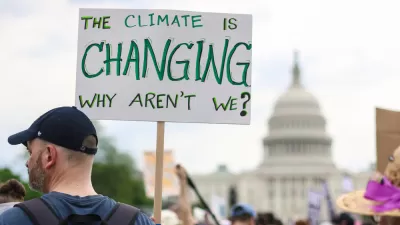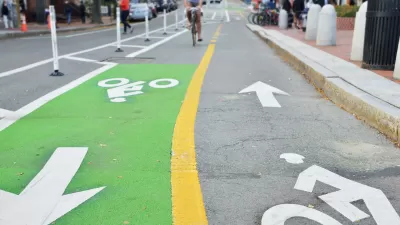It's often said that in America, urban development issues are decided at the local level. In general the rule of thumb is accurate, explaining a country home to cities as different in form as Houston, Texas and San Francisco, California. The notable exception to the rule is the country's interstate highway system, build with extensive involvement of the federal government. However, under closer inspection we can find a number of areas where federal funding and policies has a strong impact on urban development. A survey of what the leading presidential candidates are saying about urban policy suggests what priorities our next president may have.
It's often said that in America, urban development issues are decided at the local level. In general the rule of thumb is accurate, explaining a country home to cities as different in form as Houston, Texas and San Francisco, California. The notable exception to the rule is the country's interstate highway system, build with extensive involvement of the federal government. However, under closer inspection we can find a number of areas where federal funding and policies has a strong impact on urban development. A survey of what the leading presidential candidates are saying about urban policy suggests what priorities our next president may have.
Federal policies impacting urban development range from funding of new public transportation systems, tax policies (such as the mortgage interest deduction and others), historic preservation, and a host of smaller grants and programs. With a growing awareness of the link between global warming and urban development and the current surface transportation act set to expire in 2009, the next president could have the opportunity to advocate for important changes to these policies.
While I have not taken the time to comb through the candidate's statements or conduct exhaustive background research, a quick review of some of the leading candidate's policy statements finds some have interesting things to say about urban policy issues.
Barack Obama has this to say about how urban form is related to energy independence:
Build More Livable and Sustainable Communities: Over the longer term, we know that the amount of fuel we will use is directly related to our land use decisions and development patterns, much of which have been organized around the principle of cheap gasoline. Barack Obama believes that we must move beyond our simple fixation of investing so many of our transportation dollars in serving drivers and that we must make more investments that make it easier for us to walk, bicycle and access other transportation alternatives.
Reform Federal Transportation Funding: As president, Barack Obama will re-evaluate the transportation funding process to ensure that smart growth considerations are taken into account. Obama will build upon his efforts in the Senate to ensure that more Metropolitan Planning Organizations create policies to incentivize greater bicycle and pedestrian usage of roads and sidewalks, and he will also re-commit federal resources to public mass transportation projects across the country. Building more livable and sustainable communities will not only reduce the amount of time individuals spent commuting, but will also have significant benefits to air quality, public health and reducing greenhouse gas emissions.
Require States to Plan for Energy Conservation: Current law simply asks governors and their state Departments of Transportation to "consider" energy conservation as a condition of receiving federal transportation dollars. As president, Obama will require governors and local leaders in our metropolitan areas to make "energy conservation" a required part of their planning for the expenditure of federal transportation funds.
Level Employer Incentives for Driving and Public Transit: The federal tax code rewards driving to work by allowing employers to provide parking benefits of $205 per month tax free to their employees. The tax code provides employers with commuting benefits for transit, carpooling or vanpooling capped at $105 per month. This gives divers a nearly 2:1 advantage over transit users. Obama will reform the tax code to make benefits for driving and public transit or ridesharing equal.
After the Minnesota interstate bridge collapse last summer, Hillary Clinton released her "Rebuild America Plan." In it, she pledged significant funding for improvements to roads, bridges, seaports, and broadband networks. She also pledged an additional $1 billion for intercity passenger rail systems, arguing it "It is an environmentally efficient alternative to highway driving and short flights; it relieves congestion on roads and airports; reduces the emission of automotive pollutants; and it stimulates economic growth by linking metropolitan areas."
She also had this to say about public transit and local land use:
Increase federal funding for public transit by $1.5 billion per year. Increased public transit usage is arguably the best strategy for ameliorating the energy and environmental costs of transportation. As energy costs rise, more people will rely on public transportation. Today, only 5% of Americans commute by public transit, but doubling that figure could reduce carbon dioxide emissions by 25%. Public transit is also critically important to people who live in urban areas and rely on buses and trains for travel to work and school. Moreover, as the population ages, an increasing number of people will need public transit as their ability to drive diminishes. Hillary will increase federal investment in public transit by $1.5 billion per year to ensure needed capacity expansions and service level improvements.
Link federal public transit funds to local land use policies that encourage residential developments that maximize public transit usage. Over the next 25 years, a large percentage of the buildings we live, work, and shop in will be rebuilt or newly built. This presents a significant opportunity for the federal government to encourage sensible residential and commercial development that are linked to, and encourage, public transit usage. Local areas seeking large federal investments in public transit are already required to have land-use plans and policies that make investing in a high-density transit system worthwhile. Today, these requirements are focused mainly on commercial developments and not enough on residential considerations. Hillary will encourage the sort of dense residential concentrations needed to support public transit systems by better linking public transit funding with residential land-use policies. This will help to discourage sprawl and fight congestion.
John Edwards has the following policy recommendations for housing policy:
Create a Million New Housing Vouchers: Our current housing policies concentrate low-income families together, isolating willing workers from entry-level jobs and children from good schools. Edwards will create a million vouchers over five years to help low-income families move to better neighborhoods. At the same time, he will phase out housing projects that tie families to certain locations and are often lower quality and more expensive than private sector alternatives.
Revitalize Devastated Neighborhoods: Edwards believes that it is better to invest in struggling neighborhoods than abandon them. He will reform and expand the HOPE VI program to replace dilapidated housing in areas of concentrated poverty.
In his policies regarding energy, Edwards also discusses measures to reduce vehicle miles traveled:
Edwards will create incentives for states and regions to plan smart growth and transit-oriented development with benchmarks for reductions in vehicle miles traveled. He supports more resources to encourage workers to use public transportation and will encourage more affordable, low-carbon and low-ambient pollution transportation options.
Bill Richardson has said he would establish smart growth criteria for federal and state funding to "Give preference to funding for sites that comply with Smart Growth guidelines." Fellow Interchange contributor Josh Stephen noted in September that Richardson brought up land use during an interview, stating he'd support policies addressing environmental justice, encourage "a smart land-use policy," and support energy efficient transportation like like light rail.
While I couldn't find statements on these issues on the Republican candidate's websites during a brief review, it was mostly because they have chosen to highlight other topics. As groups like Smart Growth America are quick to point out, urban development policies are not strongly partisan and can result in unlikely allies working towards common goals. While they may not campaign on them, Republican candidates will also face these issues if elected president.
What are your reactions to the positions above--do they go far enough? What candidate positions or issue areas am I ignoring?

Planetizen Federal Action Tracker
A weekly monitor of how Trump’s orders and actions are impacting planners and planning in America.

Congressman Proposes Bill to Rename DC Metro “Trump Train”
The Make Autorail Great Again Act would withhold federal funding to the system until the Washington Metropolitan Area Transit Authority (WMATA), rebrands as the Washington Metropolitan Authority for Greater Access (WMAGA).

The Simple Legislative Tool Transforming Vacant Downtowns
In California, Michigan and Georgia, an easy win is bringing dollars — and delight — back to city centers.

DC Backpedals on Bike Lane Protection, Swaps Barriers for Paint
Citing aesthetic concerns, the city is removing the concrete barriers and flexposts that once separated Arizona Avenue cyclists from motor vehicles.

In These Cities, Most New Housing is Under 441 Square Feet
With loosened restrictions on “micro-housing,” tiny units now make up as much as 66% of newly constructed housing.

Albuquerque’s Microtransit: A Planner’s Answer to Food Access Gaps
New microtransit vans in Albuquerque aim to close food access gaps by linking low-income areas to grocery stores, cutting travel times by 30 percent and offering planners a scalable model for equity-focused transit.
Urban Design for Planners 1: Software Tools
This six-course series explores essential urban design concepts using open source software and equips planners with the tools they need to participate fully in the urban design process.
Planning for Universal Design
Learn the tools for implementing Universal Design in planning regulations.
Smith Gee Studio
City of Charlotte
City of Camden Redevelopment Agency
City of Astoria
Transportation Research & Education Center (TREC) at Portland State University
US High Speed Rail Association
City of Camden Redevelopment Agency
Municipality of Princeton (NJ)






























